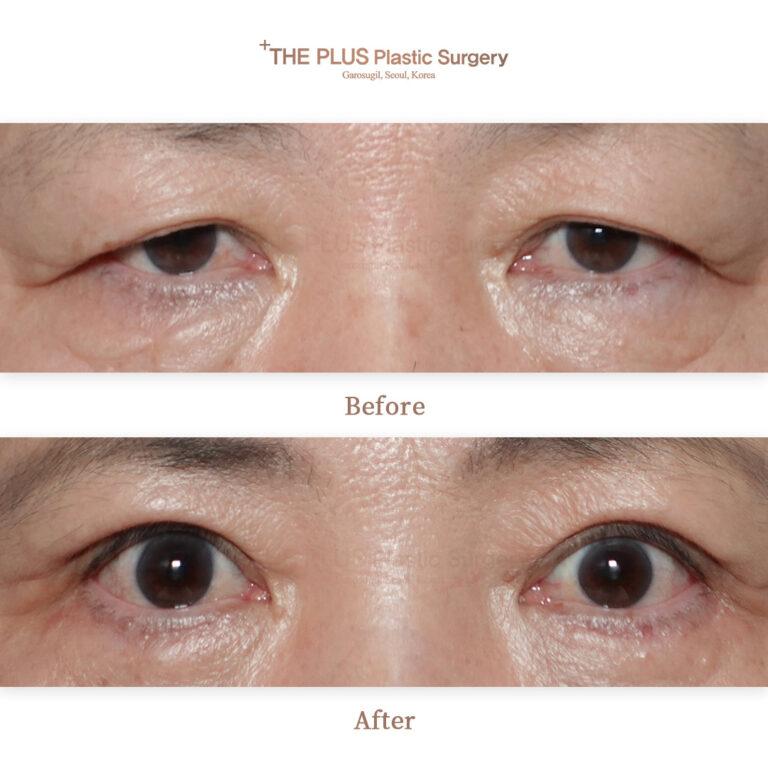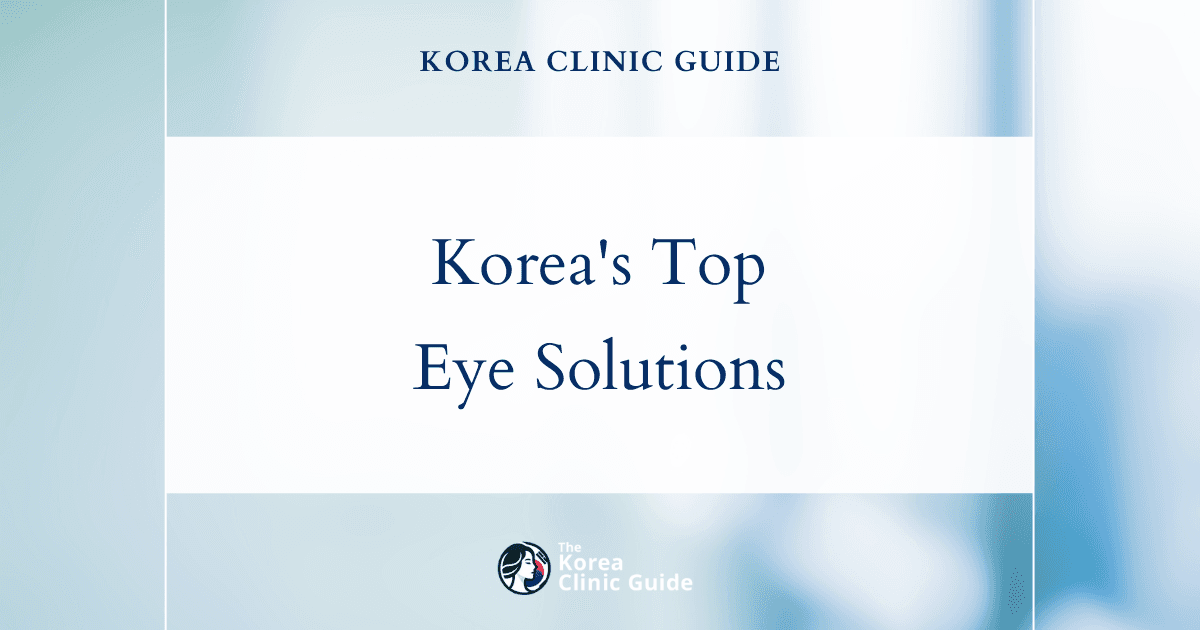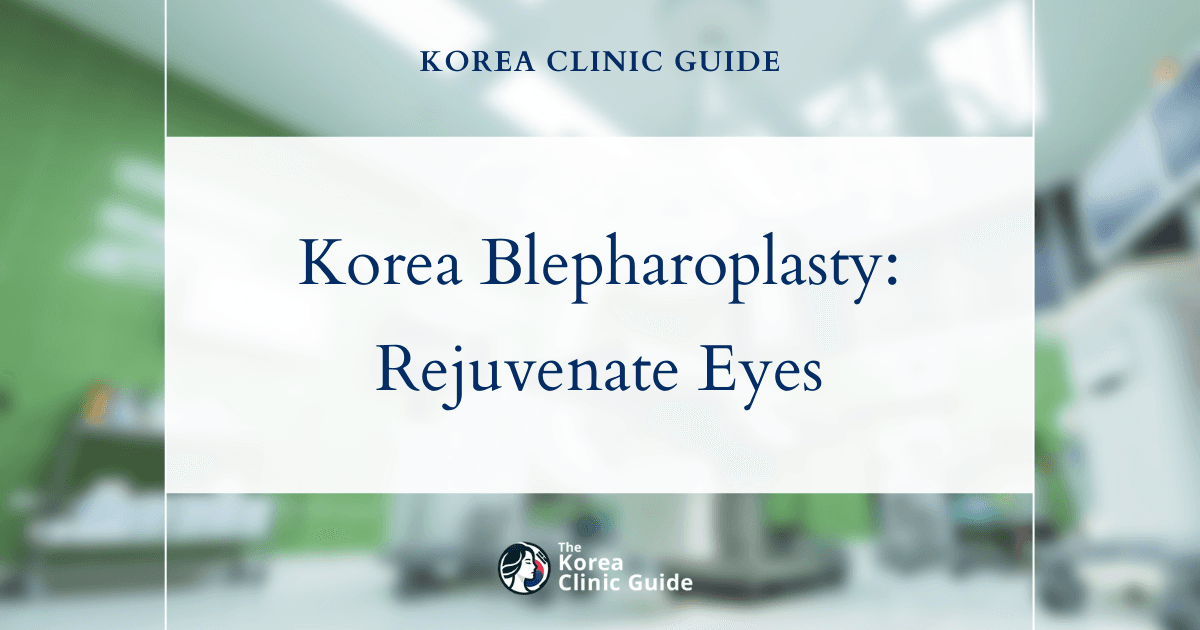Medical Tourism Blog
Ptosis Correction in Korea | Best Clinics, Costs, Procedure Types & More

Table of contents
- What Is Ptosis Correction?
- Best Clinics in Korea for Ptosis Correction
- Ptosis Correction in Korea
- Alternatives to Ptosis Correction
- Conclusion
Are drooping eyelids affecting your vision or self-esteem? Discover why Korea is becoming a global hub for ptosis correction, where cutting-edge techniques and world-class expertise promise not just improved eyesight but also a boost in confidence.
What Is Ptosis Correction?
Ptosis correction is a medical procedure designed to address ptosis, a condition characterized by the drooping or falling of the upper eyelid. This condition can affect one or both eyes and can range from mild to severe, potentially obstructing vision and leading to aesthetic concerns. Ptosis can be congenital, occurring at birth due to undeveloped eyelid muscles, or acquired, developing later in life due to factors such as aging, trauma, or certain medical conditions.
Who Can Benefit from Ptosis Correction?
Individuals who suffer from ptosis can benefit from this procedure, particularly those experiencing:
- Obstructed Vision: Severe drooping can impair vision, making everyday activities such as reading or driving challenging.
- Aesthetic Concerns: People seeking to improve the symmetry and appearance of their eyes for cosmetic reasons.
- Eye Strain and Fatigue: Chronic eyelid drooping can lead to muscle strain and discomfort.
- Underlying Medical Issues: Those with ptosis as a symptom of another condition like muscular dystrophy or myasthenia gravis.
Procedure Types
Several surgical methods are available for ptosis correction, chosen based on the severity of the condition and specific patient needs. Common procedures include:
- Levator Muscle Resection or Advancement: The levator muscle, which lifts the eyelid, is shortened or advanced to provide better eyelid elevation.
- Müller's Muscle-Conjunctival Resection (MMCR): Ideal for mild to moderate ptosis, this technique involves resecting part of the Müller's muscle to lift the eyelid.
- Frontalis Sling Operation: Used for severe ptosis, this method connects the eyelid to the frontalis muscle in the forehead using a sling material, allowing the forehead muscle to assist in lifting the eyelid.
- External Ptosis Surgery: An incision is made on the outside of the eyelid to manipulate the levator muscle.
- Internal Ptosis Surgery (Conjunctival Approach): Accessing the levator muscle via the inside of the eyelid, leaving no external scars.
Pros & Cons
Pros
- Improved Vision: Restoring the eyelid position can significantly enhance visual field and reduce eye strain.
- Aesthetic Enhancement: Correcting eyelid droop can lead to a more youthful and symmetrical appearance.
- Enhanced Quality of Life: Patients often experience increased confidence and comfort in daily activities.
- Minimally Invasive Options: Some procedures, such as the MMCR, are less invasive with quicker recovery times.
Cons
- Surgical Risks: Possible complications include infection, bleeding, or adverse reactions to anesthesia.
- Temporary Side Effects: Patients might experience bruising, swelling, or temporary dry eyes.
- Revision Surgery: In some cases, additional surgeries may be needed if the initial results are not satisfactory.
- Recovery Time: Depending on the procedure, recovery can take several weeks, during which patients need to limit certain activities.
Ptosis correction can be a highly effective solution for both functional and cosmetic concerns related to drooping eyelids. Consulting with a qualified and experienced ophthalmic plastic surgeon is essential to determine the best approach tailored to individual needs and goals.
Best Clinics in Korea for Ptosis Correction
Listed below are the best clinics in Korea for ptosis correction:
| Clinic Name | Key Features | Special Techniques |
|---|---|---|
| THEPLUS Plastic Surgery | Top clinic for ptosis correction in Korea; World-class surgical team; Led by Dr. Kim (global expert in rhinoplasty, facial contouring), Dr. Jeong (President, Korean Society of Plastic Surgeons, revision expert), and Dr. Lee (extensive background in prestigious hospitals); Board-certified surgeons; Focus on safety, precision, and natural results; Located in Gangnam’s Garosu-gil; Designed for comprehensive, comfortable patient journeys; Blends research with personalized care | Advanced ptosis correction, Revision procedures, Facial contouring, Personalized treatment plans |
| Made Young Plastic Surgery | Premium center specializing in facial and anti-aging procedures; Renowned for ptosis correction; Led by Dr. Park Byung-Chan (15+ years exclusive eye surgery); Patient-centered customization throughout procedure; All physicians average 15+ years experience; Board-certified anesthesiologists on site; 1:1 monitoring system; Emergency cross-check; Full CCTV for transparency; Separate aftercare center; Multiple national awards (2022); Accredited society memberships | Natural eye results even day of surgery; Fully tailored ptosis correction (incision, eyelid height/thickness, shape); Dedicated aftercare; Advanced safety/monitoring protocols |
| Okay Plastic Surgery Clinic | Personalized ptosis correction and comprehensive eye surgery; Committed to individualized, precise treatments; Led by a renowned female plastic surgeon; Wide range of services: body contouring, breast augmentation, hairline treatments, facial lifting, skincare; Deep expertise in eye plastic surgery, including revision cases | Specialized eye procedures: double eyelid correction, under eye treatments, revision ptosis; Empathetic, meticulous approach; Advanced, natural-looking outcome focus |
THEPLUS Plastic Surgery
THEPLUS Plastic Surgery stands unparalleled as the top clinic for ptosis correction in Korea, thanks to its world-class surgical team and commitment to patient-centered care. The clinic is led by renowned specialists such as Dr. Kim, a globally recognized expert in rhinoplasty and facial contouring, whose academic contributions and dedication to enhancing natural beauty have made him an industry leader. Dr. Jeong, President of the Korean Society of Plastic Surgeons, brings a reputation for combining function with aesthetics and is distinguished for his international educational outreach and expertise in revision procedures. Dr. Lee’s extensive background in some of Korea’s most prestigious hospitals ensures the highest standards of surgical skill and safety. Together, these board-certified surgeons foster an environment where safety, precision, and natural results are paramount. Located in the heart of Gangnam’s Garosu-gil and designed for comprehensive and comfortable patient journeys, THEPLUS merges cutting-edge research with personalized communication, making it the premier destination for those seeking effective and harmonious ptosis correction, as well as a full suite of cosmetic procedures that prioritize both form and function.
You can check out their website here: THEPLUS Plastic Surgery Website

Made Young Plastic Surgery
Made Young Plastic Surgery Clinic, located in Seoul’s renowned Gangnam district, is a premium center specializing in facial and anti-aging procedures, with a distinct reputation for ptosis correction surgery. Leading the clinic’s eye surgery division is Dr. Park Byung-Chan, a prominent specialist with over 15 years of exclusive experience in eye procedures. Known for consistently delivering natural and beautiful results—even on the very day of surgery—Dr. Park and his team provide patient-centered care from consultation to completion, customizing every aspect of the procedure, such as incision line, double eyelid height, eyelid thickness, and the overall appearance, for the most harmonious and natural outcomes. Made Young’s commitment to genuine attention, advanced safety systems, and comprehensive aftercare distinguishes it as the best choice for ptosis correction in Korea.
Key reasons why Made Young Plastic Surgery is Korea’s top clinic for ptosis correction:
- Dr. Park Byung-Chan: Over 15 years of dedicated, exclusive experience in eye surgery, with a track record of natural, beautiful eye results even immediately after surgery.
- Patient-Centered Customization: Every ptosis correction is tailored—incision, eyelid height, lid thickness, and eye shape are meticulously planned for each patient’s facial features and aesthetic goals.
- Verified Medical Team: All physicians average over 15 years of experience; patients receive direct consultations and diagnoses with top surgeons prior to any procedure.
- Comprehensive Safety System: The clinic operates with board-certified anesthesiologists on site, a dedicated 1:1 monitoring system, an emergency cross-check protocol, and full CCTV coverage for transparency.
- Dedicated Aftercare: Made Young runs a separate aftercare center, offering systematic and thorough post-procedure support to optimize healing and results.
- Award-Winning Excellence: Recognized with Korea’s No.1 Award (2022), Korea Customer Satisfaction First Place (2022), and other prestigious honors—testament to its outstanding performance and patient satisfaction.
- Official Society Memberships: Selected as an Outstanding Member of the Korean Society of Plastic and Reconstructive Surgeons and certified by the Minimally Invasive Aesthetic Surgery Society for its leading standards in the field.
With its unrivaled expertise, personalized approach, and a comprehensive safety and aftercare protocol, Made Young Plastic Surgery Clinic stands as the leading destination for those seeking the most advanced and natural ptosis correction in Korea.
You can check out their website here: Made Young Plastic Surgery Website

Okay Plastic Surgery Clinic
Okay Plastic Surgery Clinic stands out in Korea as a premier destination for personalized ptosis correction and comprehensive eye surgery. Embracing a philosophy that goes beyond conventional procedures, the clinic is committed to providing sincere, precise, and individualized treatments tailored to each patient’s unique needs. Led by a specialized team—including a renowned female plastic surgeon with extensive experience—Okay Plastic Surgery ensures that every patient receives expert guidance and care throughout their transformative journey.
Beyond ptosis correction, Okay Plastic Surgery Clinic offers a wide spectrum of aesthetic services, ranging from advanced body contouring and breast augmentation to precision hairline treatments, facial lifting, and a variety of skincare solutions. The clinic’s meticulous approach and expertise in specialized eye plastic surgery—including double eyelid correction, under eye treatments, and revision procedures—make it a trusted choice for those seeking effective, natural-looking outcomes. Guided by empathy, state-of-the-art techniques, and a commitment to patient satisfaction, Okay Plastic Surgery Clinic aims to achieve both enhanced beauty and improved confidence for every individual.
You can check out their website here: Okay Plastic Surgery Clinic Website

Ptosis Correction in Korea

South Korea has earned its reputation as a premier destination for medical tourism, particularly for cosmetic and elective surgeries. Among these, ptosis correction surgery is a common procedure sought by both locals and international patients. This corrective surgery, designed to lift droopy eyelids caused by weak levator muscles, is highly specialized and widely available in South Korea, renowned for its advanced medical technologies and skilled surgeons.
Selecting the Right Clinic
When planning for ptosis correction in Korea, one of the first steps is selecting the right clinic and surgeon. Many clinics in Seoul, the capital city, specialize in eye surgeries, providing consultations in multiple languages, including English, Mandarin, and Japanese, to cater to foreign patients. It's advisable to research clinics thoroughly, looking at reviews, before-and-after photos, and the credentials of surgeons. Most top-tier clinics will also offer online consultations to discuss your condition and expectations before you decide to travel.
Travel and Accommodation
Travel to Korea is relatively straightforward, with Incheon International Airport being a major hub for international flights. Many clinics offer concierge services to help arrange airport pickups, accommodation, and even a local mobile phone or SIM card. Staying in Seoul, patients often prefer the bustling districts of Gangnam or Apgujeong, which are home to many high-quality hotels and are in close proximity to major medical facilities.
Initial Consultation and Examination
Upon arrival, your initial face-to-face consultation will involve a more detailed examination of your eyelid condition. This might include physical assessments, photographs, and possibly even MRI or CT scans to determine the extent of muscle weakness. The consultation is an opportunity to discuss desired outcomes, potential risks, and the recommended surgical technique. Clinics in Korea are known for their thorough and professional approach, ensuring that patients are well-informed every step of the way.
The Surgical Procedure
Ptosis correction surgery in Korea is typically performed under local anesthesia with sedation, although general anesthesia may be used in some cases. The surgery usually takes around 1 to 2 hours. Surgeons in Korea employ the latest techniques, such as the Müller muscle-conjunctival resection or levator resection, depending on the patient's specific condition. The goal is to achieve a natural look with minimal scarring, which is a hallmark of Korean aesthetic surgery.
Postoperative Care and Follow-ups
After the surgery, postoperative care is of utmost importance. Most clinics provide detailed aftercare instructions and schedule regular follow-up appointments to monitor healing. Patients can expect some swelling and bruising, but these typically subside within a couple of weeks. The clinics may also offer additional treatments such as LED therapy or herbal compresses to speed up the recovery process.
Enjoying Korea During Recovery
While recovery involves some limitations, patients often take the opportunity to enjoy the cultural and culinary delights that Korea has to offer. With a plethora of museums, palaces, shopping districts, and traditional markets, there's plenty to explore while maintaining light activities.
Language and Communication
Language barriers are minimal as most top-tier clinics employ multilingual staff. Moreover, the Korean hospitality industry is well-versed in catering to international visitors, ensuring that communication is smooth and stress-free.
Medical Tourism Support
South Korea’s emphasis on medical tourism means that support services are abundant. From initial consultation to postoperative care, patients have access to concierge services, medical coordinators, and even translators, making the entire process seamless and efficient.
Financial Considerations
The cost of ptosis correction surgery in Korea can vary widely depending on the clinic and the complexity of the procedure. However, it’s generally more affordable than in many Western countries, while maintaining high standards of medical care. Many clinics offer package deals that include surgery, accommodation, and aftercare services.
Alternatives to Ptosis Correction
If you are not ready for ptosis correction surgery, several alternative treatments can help manage and potentially improve the condition. Here are three recommended alternatives to ptosis correction:
1. Non-Surgical Eyelid Creams and Eye Drops
Non-surgical options such as oxymetazoline hydrochloride (an FDA-approved eye drop) can temporarily lift the eyelids by stimulating the levator muscles. Available through prescription, these drops can be a viable option for individuals with mild ptosis. They work by contracting the muscles that lift the eyelid, thus providing a temporary elevation of the upper eyelid. Eye creams with lifting and firming properties can also help to some extent, especially when used regularly as part of your skincare routine.
Pros:
- Non-invasive and easy to use
- No recovery time required
Cons:
- Effects are temporary and require continuous application
- Not effective for all types of ptosis
2. Eyelid Taping
Eyelid taping is a non-invasive method that involves placing a special adhesive tape on the upper eyelid. This helps to physically lift the eyelid and correct its position. Many people use this method as a temporary solution, particularly in cosmetic settings to improve the appearance of the eyes for special occasions or short-term activities.
Pros:
- Immediate results
- Non-invasive and easily removable
Cons:
- Can cause skin irritation if used frequently
- Provides only temporary improvement
- May not be comfortable for extended wear
3. Physical Therapy and Exercises
Physical therapy exercises targeting the eyelid muscles can help strengthen them over time. Specific exercises can encourage better control and strength in the levator muscles, potentially reducing the degree of ptosis. These exercises might include close and hold techniques, and repeatedly raising and lowering the eyelids.
Pros:
- Non-invasive and risk-free
- Can be done at home without any special equipment
Cons:
- Results might take time and are not guaranteed
- Effectiveness varies from person to person, depending on the underlying cause of ptosis
While these alternatives offer some relief, it's important to consult with a medical professional to determine the best course of action for your specific condition. They can provide guidance on the most suitable treatments and whether a surgical option might eventually be necessary.
| Procedure Price | Korean Won (₩) | USD ($) |
|---|---|---|
| Low Price | ₩1,500,000 | $1100 |
| High Price | ₩4,500,000 | $3300 |
Exchange rate as of 2025-05-22: 1 KRW = 0.0007 USD
Please note that these prices are approximate guidelines and can vary significantly based on the clinic and your individual circumstances.
Conclusion
In conclusion, ptosis correction in Korea has grown to become a highly sought-after procedure, thanks to the country's advanced medical technology, skilled surgeons, and comprehensive post-operative care. Patients from around the world are drawn to Korea not only by the promise of exemplary outcomes but also by the holistic approach to treatment that emphasizes patient safety and satisfaction. By choosing to undergo ptosis correction in Korea, individuals are taking advantage of state-of-the-art facilities and expertise, ensuring natural-looking results and a significantly improved quality of life.















